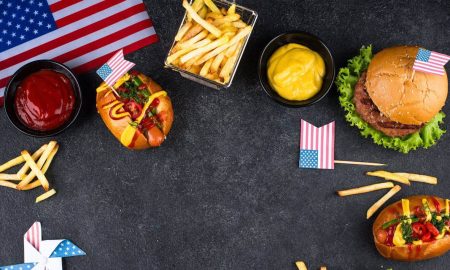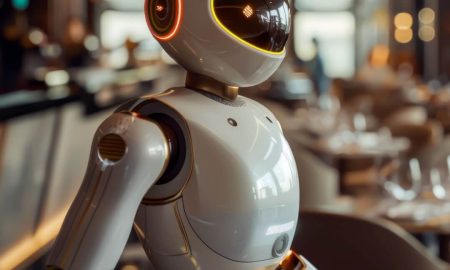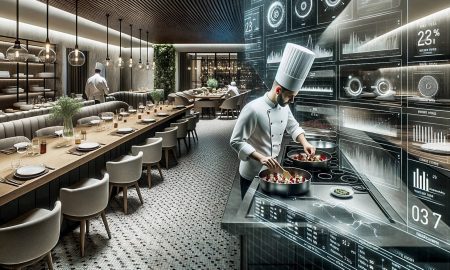And then it starts: layer by layer, a filigree shell of sweet potato and pumpkin puree begins to appear on the plate, as if by magic. Welcome to FoodInk, the world’s first 3D-foodprinting restaurant. It’s giving “hot off the presses” a whole new meaning.
Beef tartar ex machina
FoodInk’s goal is to give its customers the ultimate 3D experience; everything here is 3D printed, from the flatware to the menus to the table decorations. At the start of the meal, customers receive a VR headset that takes them on a journey through outer space… so they can just sit back and fly through the universe while they wait for the FoodInk team to come by with their appetizers. Everything about this pop-up restaurant screams, “Welcome to the future!”

foodprint / Image: 3DFP Ventures Ltd.
FoodInk has toured all over the world with its concept, and it’s not even the only one doing it. Culinary printouts are finding their way into fine dining more and more often these days – whether it’s the French-influenced American snacks at Mélisse in California, or the printed pastries at La Boscana in Catalonia. So while you’re at home battling it out with your regular printer, someone out there is using theirs to make beef tartar. Of course, you still have one thing in common: sooner or later, you both have to refill the cartridges. At the end of the day, it’s all just technology.
Drink-jet printing?
Star-Trek fans all over the world have always known that one day we’d all be eating curry chicken with rice and carrots served hot out of the replicator. And now we can! Well, almost… 3D food printing is certainly a big step in that direction, though it doesn’t “beam” the food so much as extrude it in layers.
Theoretically, any ingredient can be used in printing, as long as it’s in pureed form. The puree goes into a cartridge, which goes into the printer, just like usual. Users can download the shape they want wirelessly, or choose one on a printer app. Everything else is just like a normal printing job, except with one extra dimension: individual layers are printed on top of one another to create a 3D form. As with regular printers, different “inks” come out of different “jets”, so the food doesn’t need additional stabilizers to help the food hold its shape. The process does require some knowledge and experience, though, because different foods react differently to the printing process.
Sieh dir diesen Beitrag auf Instagram an
Thanks to an ever-greater selection of 3D food printers, users have a huge variety of raw ingredients at their disposal: the Choc-Edge, developed in Spain, creates delicate works of chocolate art; the ChefJet spins sugar into geometric forms; and the Foodini prints out pizza, pasta and quiche. The possibilities are endless!
All the rage
Experts are already predicting that food printing will become part of our culinary lives both in restaurants and at home. Manufacturers claim that, unlike mass-produced industrial food products, smart food printers will actually boost our nutrition, allowing us to print fresh, healthy meals out right in our kitchens — maximum transparency with minimum time and effort. It’s also easy to add vitamins and minerals to ingredients before printing, so users will be able to plan their meals right down to the last micronutrient. The prospect of being able to add different nutrients to the same food, tailoring them to individual diners, will be transformative to the field of nutrition research.

3D food print | Image: 3DFP Ventures Ltd.
Picture it: early morning in the not-too-distant future. You trundle out of bed and use a touch pad to measure your nutritional needs. Uh oh, low on calcium? You punch a few buttons, and your 3D food printer nutritionally optimizes your breakfast before churning it out. Personalized food for everyone? Food experts anticipate it becoming a reality within the next ten years.
Prints Charming: opportunities for the restaurant industry
The ability to customize food like this opens up a whole new world of opportunity for aspiring restaurateurs. Personalized pasta, breathtaking chocolatey creations, avant-garde plate geometry… 3D food printing is an ingenious symbiosis between haute cuisine and scientific precision, allowing chefs to serve masterpieces that human hands could never create.
Mateo Blanch, chef at La Boscana, uses this symbiosis to create dining experiences like nothing his customers have ever imagined. They watch their desserts manifest on their plates, precise spirals of chocolate so fine and symmetrical they’re almost hypnotic — a feast for the eyes and the tongue alike.
Food printers help chefs express their own culinary skills on a whole new level. There’s no such thing as “too complicated” anymore; all the world’s a stage for spectacular new ideas. Or as Paco Perez, chef at La Enoteca in Barcelona, puts it: “Creativity is shaped into whatever technology allows.”
An idea that’s easy to swallow
For the five million people in Germany who suffer from dysphagia, pureed food in 3D form could prove nothing less than revolutionary. Dysphagia is the medical term for difficulty swallowing; many patients find it impossible to eat solid food. Currently, most subsist on food in “baby food” form, either simply as puree or perhaps pressed into a mold to make it look a little nicer. Diners aren’t fooled, of course, and generally don’t find the mushed-up meals appealing in any way — which affects their quality of life and can result in malnutrition. A research team at Weihenstephan-Triesdorf College has been working for years to combat this by developing technology to print entire meals in more appetizing forms. The project has so much potential that it’s even got EU backing, and will soon begin production on an industrial scale.

Image: 3DFP Ventures Ltd.
And there’s more! You’ve all seen those sad, smushed looking bananas covered in black spots, right? Studio H, a South African startup, has decided we’ve all wasted enough food, and started its Salad 2.0 project with the goal of ending “fruit discrimination and waste” by making damaged produce beautiful again. Every year, around eight million tons of food are thrown away in Germany alone (Source), much of it produce that no longer meets consumers’ standards of what fruit and veggies ought to look like. That’s where Salad 2.0 comes in. The startup is turning “ugly” fruit into tasty fruit purees and then using 3D food printers to make them into creative shapes. Besides giving scorned apples and bananas a second shot at life, the 3D printed produce also makes nutritious eating more fun for kids.
So is food printing really the next big thing? The great architect Louis Sullivan once said that “form follows function” when it comes to art. 3D food printing flips that idea around: here, “function follows form”. One look at the spectacular results, and you’ll be inclined to call them “art” anyway.
Further trends you need to know:
How insects are revolutionizing gastronomy
Aquaponics: symbiotic habitats for food of the future

















